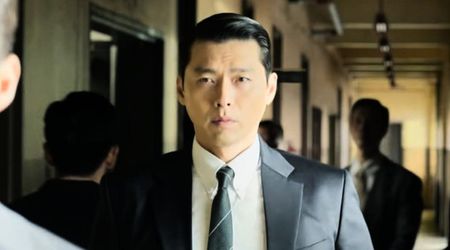From TV's darling to Hollywood's outcast, Rebecca Gayheart's fall was swift and sudden

If you grew up in the 90s, chances are you probably remember Rebecca Gayheart. After all, she made cosmetic products famous. Between 1991 and 1993, she was called the Noxzema Girl, who got rid of zits on her face and gained enough confidence to talk to a man. In retrospect, it's safe to say that the Noxzema commercial defeated feminism by centuries.
It captured the cheruby sweetness of a shy teenage girl too scared to talk to a cute guy and all because of a few pimples on her cheeks. However, the advert placed her squarely in the American public's popular imagination. Her auburn curls falling loosely on the sides of her wide, surprised eyes and full lips made Gayheart attractive, seductive and infinitely lovable.
The actress/model, who is part Irish, German and Cherokee, burst into pop culture with a face that was luminous with equal parts innocence and ruggedness. In other words, she was sexy yet coy; self-assured but hesitant, and for the American audience, Gayheart served as the prototype of a modern woman yet to come into her own.
A much older version of this stereotype was being portrayed by Julia Roberts who was well on her way to becoming America's sweetheart in the early 90s. For a while, many believed Gayheart would grow up to embody Roberts' earthy quality on screen, and that dream didn't seem far-fetched. Gayheart, all of 17 when the Noxzema advert released, was already in talks to transition from modeling to acting and she found her big break.


In 1992, she landed a role in ABC's daytime soap opera, 'Loving' as Hannah Mayberry for 18 months, after which, she moved to Los Angeles and starred in the NBC miniseries, 'Invasion' and finally, appeared in a highly successful 10 episode run on 'Beverly Hills: 90210' in 1995. Gayheart's character, Antonia Marchette, was every bit the tragic romantic heroine who's teary eyes and sentimentality evoked memories of a past time when love was simple and unconditional.
Antonia's defiance of her mobster father and marriage to Dylan, who plotted her dad's murder, exposed the difficult situations women often come to occupy and the audience showed immense compassion.

From then on, Gayheart was television gold. She was relatable as the girl-next-door who was gifted with beauty, strength, and conviction- traits that resonated with women who tuned in to watch 90210. Fans of the CW show admired Antonia's steely determination and were inspired by her plotline. So what if it was a cliched, hackneyed story that's been regurgitated several times in cinema and on TV?
It seemed like her success on television had finally taken off even if she was yet to get her first lead role. Gayheart, however, had already set her eyes on the next big transition: Hollywood. Her boyfriend at the time, Brett Ratner, was already a famous filmmaker fresh on the heels of 'Rush Hour' and she wanted to make her own mark. Nonetheless, this proved to be a little more difficult as she began to be typecast for roles cemented in theatrics rather than nuance.

In the late 90s, she landed film deals and appeared as a feather-brained character in teenage movies centered on crime and horror. Gayheart had a cameo on 'Scream 2,' played a popular high school student in 'Jawbreaker' and took on the role of a deranged Brenda Bates in 'Urban Legend.'
In all of them, she stayed on the sidelines as her contemporaries Sarah Michelle Geller, Rose McGowan, and Neve Campbell figured prominently. But Gayheart, the small town girl from Pine Top Kentucky, went on to play her part, hoping something big would come her way. And it did, by way of a scandal that ended her career just as it was starting.

In 2001, Gayheart's Jeep Grand Cherokee struck third grader Jorge Cruz Jr. just as he was crossing the street on his way home from school.
He died the following day at Children's Hospital, Los Angeles. She pleaded no contest to his parents' wrongful death lawsuit and denied negligence. She was sentenced to three years probation, one year suspension of her driving license, a $2,800 fine and 750 hours of community service.
It was this accident that soiled her image as the girl-next-door. After all, her fans, most of whom were urban and elite didn't have a brush with the law. For the next four years, she receded from the spotlight and underwent therapy. In an interview with People, Gayheart said, "I just got to a point where I realized I needed help. I got into therapy. I’ve been in therapy since then. It’s really been helpful."
Apart from professional help, falling in love with 'Grey's Anatomy' star Eric Dane healed her in many ways.

Their wedding in 2004 at a chapel in Las Vegas enriched her personal life but her life in Hollywood sadly came to an end. She began to appear in movies that failed to make a mark at the Box Office and her TV career was fledging.
Gayheart's fame had turned against her and the release of a controversial naked video featuring her, Dane and former Miss U.S. Teen Kari Ann Peniche in 2009 didn't help either. At this point, the actress's innocence seemed to have vanished and in its place stood glaring examples of what her fans came to identify as recklessness.

The actress, who got catapulted to fame by appearing in an Noxzema ad, was no longer ascribed with the sweetness that once defined her.
Gayheart instead reinvented herself as a mother and a strong wife to Dane, who struggled with addiction to prescription pain medications. By this time, her bundles of curls disappeared and she stood on the red carpet with straight, slick hair that hardly distinguished her from other celebrities in Hollywood.
Life, it seemed, had robbed her of the radiance she once emitted. This was evident when she was photographed arriving at a friend's house in Los Angeles after filing for divorce from Dane in February this year.
Although she displayed a smile for the paparazzi, it was no longer one that shone with the same charisma that gave her the title, Noxzema Girl.










